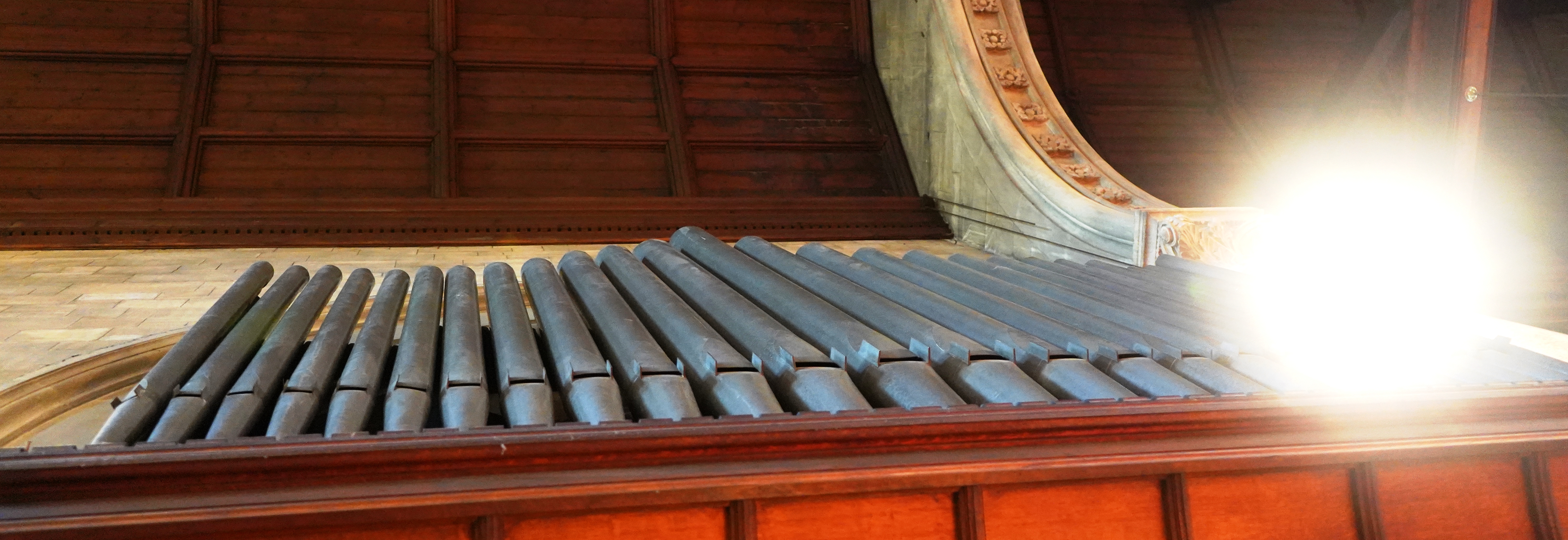Musical Fireworks Light up the Summer
Peter Day reports on June’s celebration of St Peter’s newly restored organ.
The church of St Peter de Beauvoir is a landmark for the whole area, familiar even if you never venture inside. The organ that accompanies Sunday services is a rather historic instrument, and it has recently been refurbished. This is its story.
As London rapidly expanded in the mid 1800s, developers built their new suburbs around a square, a church and a school. St Peter De Beauvoir was erected in 1841, a beacon for the De Beauvoir estate. The school was in the crypt below. Forty years later, the church was extended with a chancel at the east end, curiously in Romanesque style with round arches. The main body of the church is pointy-arched Gothic Revival, inspired by a style that actually replaced the Romanesque tradition. Back-to-front architectural history, you might say.
Part of the 1884 addition was the new organ, positioned on the south side of the chancel so that most members of the congregation don’t see it, they just hear it. The mid-Victorian Church of England was still under the sweeping influence of the Anglo-Catholic Oxford Movement. In that tradition, the organ’s main role was to accompany the choir at the front of the church, not stand out in its own right.
The organ was built by the London firm of JW Walker. The firm is still in existence, now based in Suffolk and Wiltshire. The business was ‘one of the better Victorian builders’, according to the firm’s consultant, William McVicker. After examination of the instrument, McVicker determined that it is largely unaltered from the original, although four stops were added in 1974. This later work, he said, was done in sympathy with the original instrument.
McVicker’s verdict on the St Peter’s organ was heartening: ‘The whole instrument is delightful,’ he wrote. ‘The instrument seems relatively old-fashioned for its date. It represents one of the last gasps of English conservatism in organ building, representative of the kind of organ built by builders most of whose businesses did not ultimately survive and who failed to modernise successfully in the final quarter of the nineteenth century.’
And he summed up: ‘The survival of the St Peter’s organ is therefore to be cherished.’
Casual visitors agree with this assessment. One of them – quite recently – was Brian Gill. He is a Scottish law lord who was visiting a friend in De Beauvoir. He is also a keen organist, who happens to be chairman of the Royal School of Church Music – the influential body which promotes church musicianship and training. Brian Gill sat down at the organ, and when he played it, he liked what he heard. ‘All it needs is a little tender loving care,’ he said.
But who would provide that? St Peter’s already had an embryo project to restore the organ, inspired by money donated by the late Michael Haines, a prominent De Beauvoir resident and former treasurer at the church. But every expert called in to advise on the restoration had different ideas… and each idea had a different price tag.
Lord Gill’s advice provided the significant nudge that was needed. Don’t do a large-scale rebuild of such an unchanged instrument: clean it up, rectify the worn-out mechanical parts, make it fit for another 50 years, but don’t radically alter this significant survival.
But even a modest restoration needs skilled expertise and costs thousands of pounds. It is only a few years since St Peter’s raised a big chunk of money to refashion the crypt into a community meeting place. Money-raising like this takes much oomph from volunteers, so another big fund-raising campaign so soon after the one for the crypt was difficult to contemplate.
But then, quite by chance, Albert Hustwayte, a long-standing member of the congregation, left St Peter’s a significant amount of money in his will. This made it possible for the TLC to be administered, by the Hampshire-based firm Organ Design.
The work takes time and craftspersonship. Each sound has a separate pipe or reed and the St Peter’s organ has 1,090 of them. Each one had to be removed and cleaned, and some of them needed specialist attention where the fairly soft metal had worn away.
The pipes are connected to the keyboard (or the pedalboard) by links called trackers, each of which needed fiddly attention. The keyboards were sent off to another specialist for refurbishment, including the replacement of the ivory keys by plastic ones. Using elephant ivory is now illegal, so this work was essential. ‘But it’s like a set of new dentures,’ mourned the St Peter’s organist, Romee Day, rather regretfully.
It took months to complete the work but the refurbished organ is now set up for decades more service. And to mark the re-emergence of something that can be regarded as a De Beauvoir landmark, St Peter’s held a celebration concert in June 2018-– a community event with the guest organist Stuart Whatton, the trumpeter Peter Wright and an augmented St Peter’s Choir, conducted by David Millington.
A cherished organ is now spruced up and ready to make an even more joyful noise unto the lord in the years to come.






